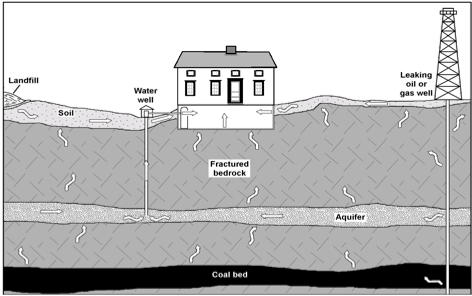Drilling and stray natural gas migration
From Wikimarcellus
Stray natural gas migration refers to the movement of natural gas (mostly methane) through bedrock and soil. It can leak from a variety of sources, including reservoir rock, coal seams, landfill, or pipelines. It can also occur from drilling any well--gas, oil or water--as well as from abandoned wells. Whenever the water table is penetrated by drilling a well, methane gas may be given an escape route. It tends to move from areas of high pressure to low.
Contents |
Identifying Stray Gas
Stray gas is quite common in regions of North America that are undergirded by hydrocarbon deposits, such as in southwestern and northeastern Pennsylvania. It can be found throughout the central and northern Appalachian Basin. When it occurs, it can be broken down into three main categories:
- Sub-surface microbial gas. These originate in deep sea sediments and may be identified as drift gas.
- Near-surface microbial gas often from landfills or naturally occurring marsh gas.
- Thermogenic gas consisting of natural gas or coal-bed gas.
These gasses can blend together into a mixture. The origin of stray natural gas may only reliably be determined by its chemical signature.
Factors Affecting Gas Migration
The general rule is that stray natural gas moves from areas of high pressure to ones of lower pressure. However several factors can, come into play that influence migration. These include changes in barometric pressure, porosity and permeability of soil and bedrock, temperature differentials, rain or snow.
Stray Gas Regulatory Environment
Pennsylvania has taken an aggressive stance towards regulating stray gas originating from drilling operations. Obviously, there is little that can be done to regulate naturally-occurring gas migration. The state issued new drilling regulations in 2011 to help combat gas leaks from drilling operations.
The Pennsylvania Oil and Gas Act
The Pennsylvania Oil and Gas Act of 2011 automatically assumes whenever a new well is drilled within 1,000 feet of a drinking water supply, and contamination such as stray gas or chemical occurs within six months of drilling, that the operator is at fault. Thus, in order to either establish or else avoid blame, it is important for both the water supply owner/homeowner in addition to the well operator to obtain test samples of the drinking water before drilling begins. Well operators must report any incidents of contamination to PDEP within 24 hours once it is in fact discovered.
Regulation of Well Casings
The Act focuses regulating well casings and cementing as one possible source of stray gas, and specifies construction standards and requirements that bring Pennsylvania' drilling regulations up to the same standard as several other states. The purpose is to provide greater protection for home and property owners from contaminated drinking water. Also blow-out preventers--essentially large valve or a series of valves that can be triggered remotely to close-off a well bore--are required on all natural gas wells.
Operator Held Liable
Under this Act, whenever there is any contamination of drinking water, the well operator is held liable for replacing the damaged water supply. Operators are also required to notify PDEP promptly in the event of any complaints regarding natural gas migration. Emergency responders are to be summonsed when high concentrations of gas are noticed.
Marcellus Shale Coalition Recommended Practices on shale gas
The Marcellus Shale Coalition is a membership organization made up of natural gas exploration and production companies as well as suppliers to that industry. In October, 2012 the Coalition issued a guidance document on how operators should handle stray gas incidents. Operators are advised to act very proactively in event of any report of gas migration.


